Assessment of Leadership Techniques and Styles of Herbert Hoover
VerifiedAdded on 2023/06/04
|13
|4537
|272
AI Summary
The report analyses the leadership techniques and styles of Herbert Hoover, one of the prime leaders post World War. It discusses different leadership styles, team collaboration, and productivity. The report is a summation of the ways in which the assessment is being done under the leadership process and techniques.
Contribute Materials
Your contribution can guide someone’s learning journey. Share your
documents today.
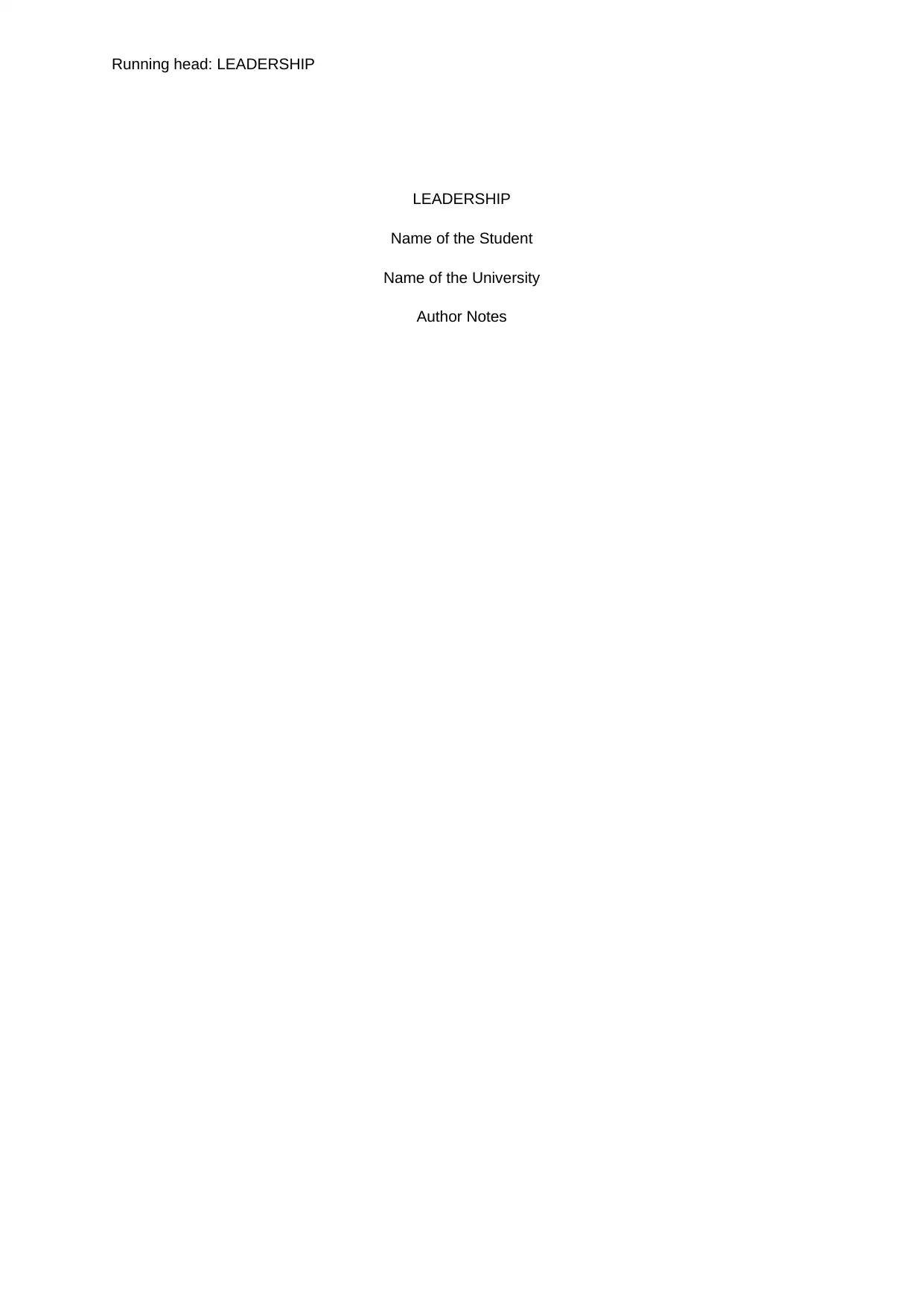
Running head: LEADERSHIP
LEADERSHIP
Name of the Student
Name of the University
Author Notes
LEADERSHIP
Name of the Student
Name of the University
Author Notes
Secure Best Marks with AI Grader
Need help grading? Try our AI Grader for instant feedback on your assignments.
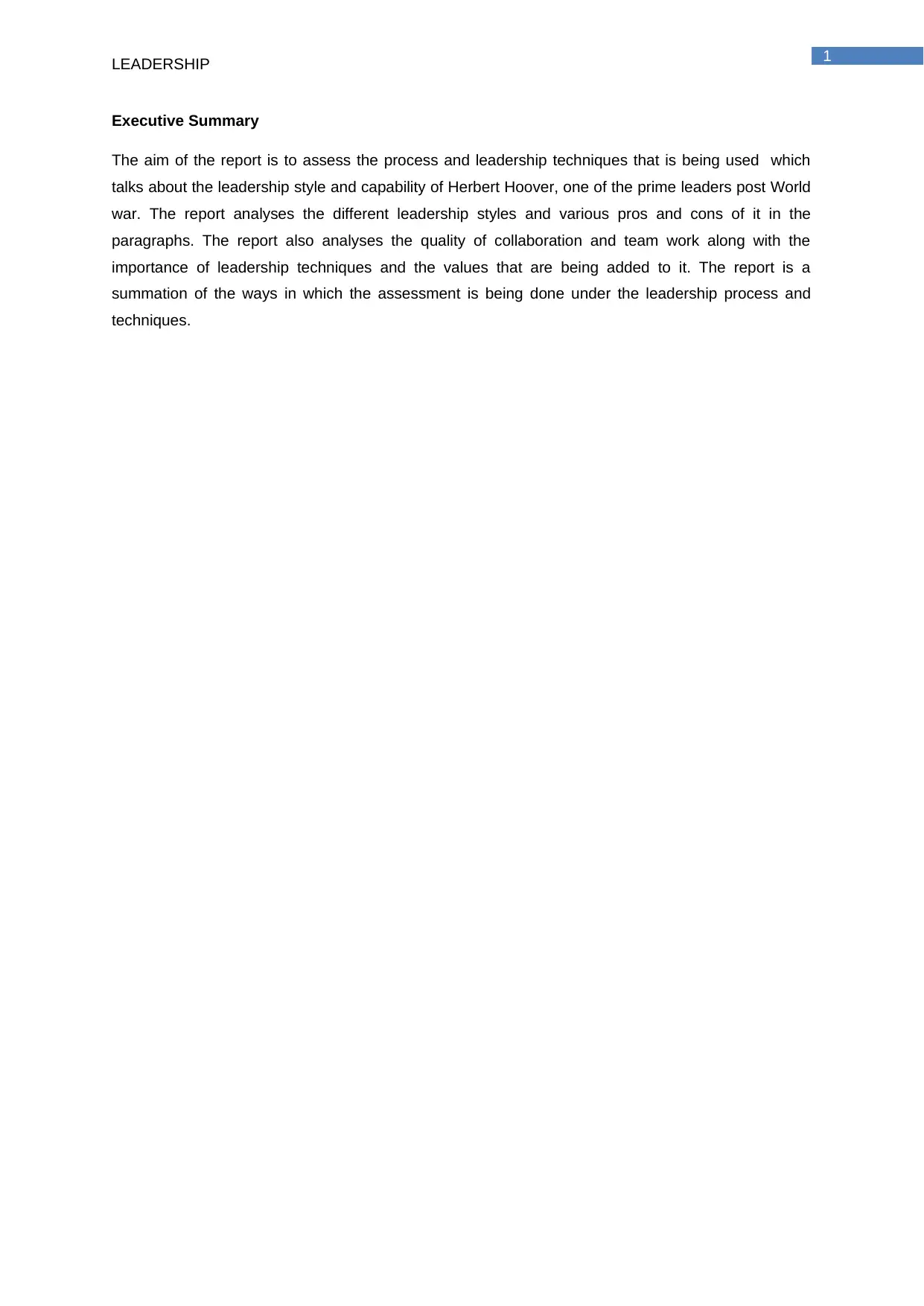
1
LEADERSHIP
Executive Summary
The aim of the report is to assess the process and leadership techniques that is being used which
talks about the leadership style and capability of Herbert Hoover, one of the prime leaders post World
war. The report analyses the different leadership styles and various pros and cons of it in the
paragraphs. The report also analyses the quality of collaboration and team work along with the
importance of leadership techniques and the values that are being added to it. The report is a
summation of the ways in which the assessment is being done under the leadership process and
techniques.
LEADERSHIP
Executive Summary
The aim of the report is to assess the process and leadership techniques that is being used which
talks about the leadership style and capability of Herbert Hoover, one of the prime leaders post World
war. The report analyses the different leadership styles and various pros and cons of it in the
paragraphs. The report also analyses the quality of collaboration and team work along with the
importance of leadership techniques and the values that are being added to it. The report is a
summation of the ways in which the assessment is being done under the leadership process and
techniques.
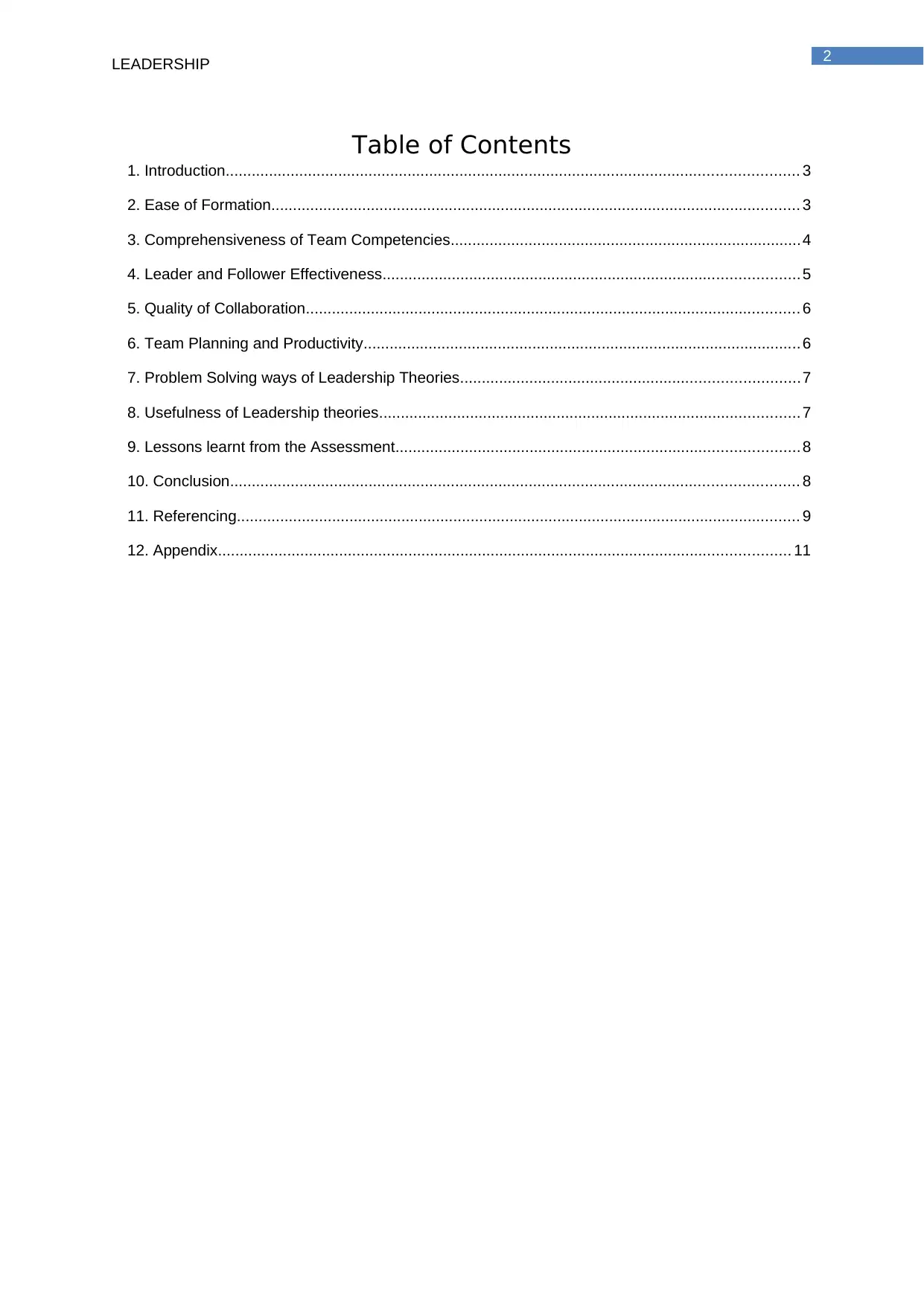
2
LEADERSHIP
Table of Contents
1. Introduction.................................................................................................................................... 3
2. Ease of Formation.......................................................................................................................... 3
3. Comprehensiveness of Team Competencies.................................................................................4
4. Leader and Follower Effectiveness................................................................................................ 5
5. Quality of Collaboration.................................................................................................................. 6
6. Team Planning and Productivity..................................................................................................... 6
7. Problem Solving ways of Leadership Theories..............................................................................7
8. Usefulness of Leadership theories................................................................................................. 7
9. Lessons learnt from the Assessment............................................................................................. 8
10. Conclusion................................................................................................................................... 8
11. Referencing.................................................................................................................................. 9
12. Appendix.................................................................................................................................... 11
LEADERSHIP
Table of Contents
1. Introduction.................................................................................................................................... 3
2. Ease of Formation.......................................................................................................................... 3
3. Comprehensiveness of Team Competencies.................................................................................4
4. Leader and Follower Effectiveness................................................................................................ 5
5. Quality of Collaboration.................................................................................................................. 6
6. Team Planning and Productivity..................................................................................................... 6
7. Problem Solving ways of Leadership Theories..............................................................................7
8. Usefulness of Leadership theories................................................................................................. 7
9. Lessons learnt from the Assessment............................................................................................. 8
10. Conclusion................................................................................................................................... 8
11. Referencing.................................................................................................................................. 9
12. Appendix.................................................................................................................................... 11
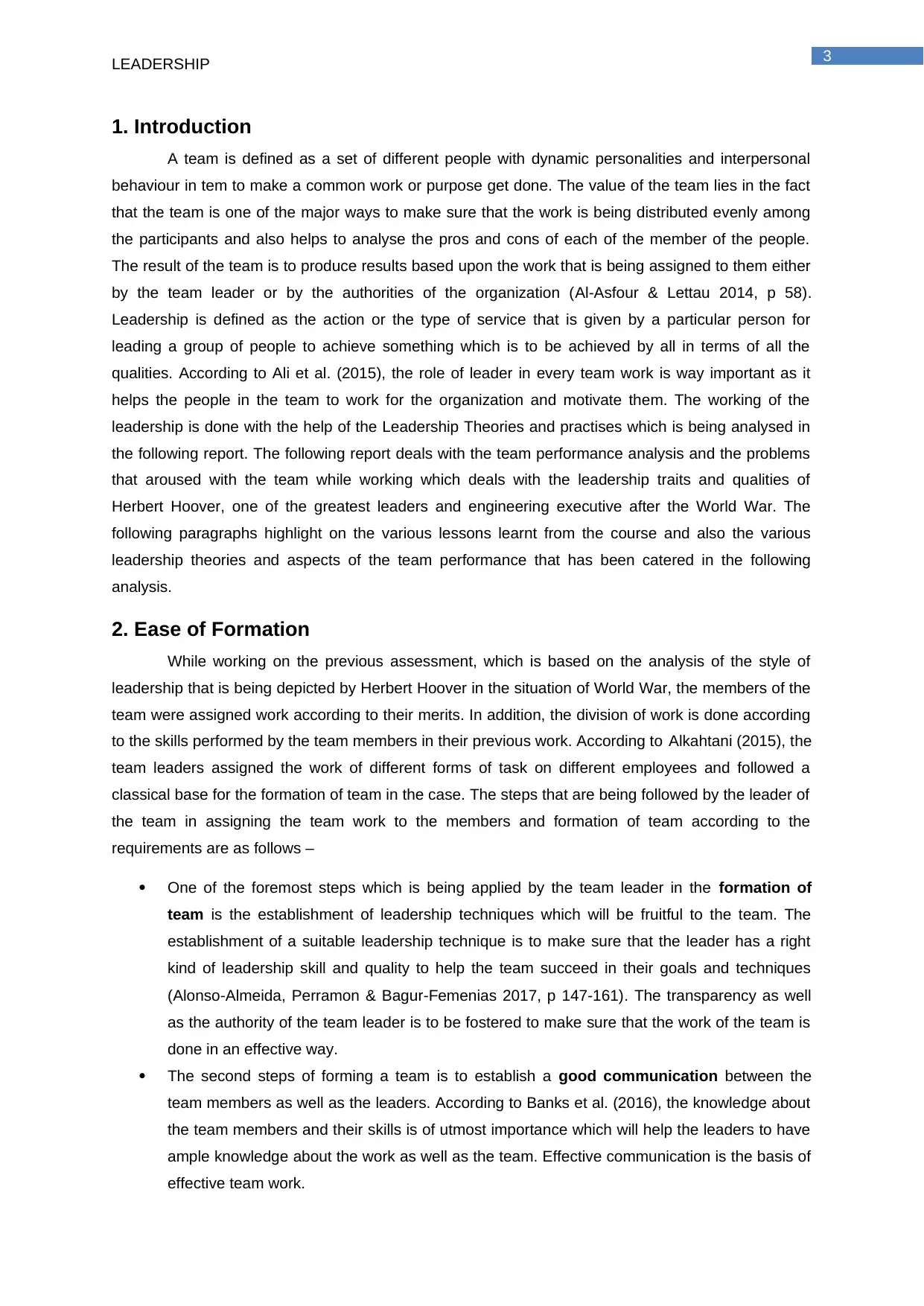
3
LEADERSHIP
1. Introduction
A team is defined as a set of different people with dynamic personalities and interpersonal
behaviour in tem to make a common work or purpose get done. The value of the team lies in the fact
that the team is one of the major ways to make sure that the work is being distributed evenly among
the participants and also helps to analyse the pros and cons of each of the member of the people.
The result of the team is to produce results based upon the work that is being assigned to them either
by the team leader or by the authorities of the organization (Al-Asfour & Lettau 2014, p 58).
Leadership is defined as the action or the type of service that is given by a particular person for
leading a group of people to achieve something which is to be achieved by all in terms of all the
qualities. According to Ali et al. (2015), the role of leader in every team work is way important as it
helps the people in the team to work for the organization and motivate them. The working of the
leadership is done with the help of the Leadership Theories and practises which is being analysed in
the following report. The following report deals with the team performance analysis and the problems
that aroused with the team while working which deals with the leadership traits and qualities of
Herbert Hoover, one of the greatest leaders and engineering executive after the World War. The
following paragraphs highlight on the various lessons learnt from the course and also the various
leadership theories and aspects of the team performance that has been catered in the following
analysis.
2. Ease of Formation
While working on the previous assessment, which is based on the analysis of the style of
leadership that is being depicted by Herbert Hoover in the situation of World War, the members of the
team were assigned work according to their merits. In addition, the division of work is done according
to the skills performed by the team members in their previous work. According to Alkahtani (2015), the
team leaders assigned the work of different forms of task on different employees and followed a
classical base for the formation of team in the case. The steps that are being followed by the leader of
the team in assigning the team work to the members and formation of team according to the
requirements are as follows –
One of the foremost steps which is being applied by the team leader in the formation of
team is the establishment of leadership techniques which will be fruitful to the team. The
establishment of a suitable leadership technique is to make sure that the leader has a right
kind of leadership skill and quality to help the team succeed in their goals and techniques
(Alonso‐Almeida, Perramon & Bagur‐Femenias 2017, p 147-161). The transparency as well
as the authority of the team leader is to be fostered to make sure that the work of the team is
done in an effective way.
The second steps of forming a team is to establish a good communication between the
team members as well as the leaders. According to Banks et al. (2016), the knowledge about
the team members and their skills is of utmost importance which will help the leaders to have
ample knowledge about the work as well as the team. Effective communication is the basis of
effective team work.
LEADERSHIP
1. Introduction
A team is defined as a set of different people with dynamic personalities and interpersonal
behaviour in tem to make a common work or purpose get done. The value of the team lies in the fact
that the team is one of the major ways to make sure that the work is being distributed evenly among
the participants and also helps to analyse the pros and cons of each of the member of the people.
The result of the team is to produce results based upon the work that is being assigned to them either
by the team leader or by the authorities of the organization (Al-Asfour & Lettau 2014, p 58).
Leadership is defined as the action or the type of service that is given by a particular person for
leading a group of people to achieve something which is to be achieved by all in terms of all the
qualities. According to Ali et al. (2015), the role of leader in every team work is way important as it
helps the people in the team to work for the organization and motivate them. The working of the
leadership is done with the help of the Leadership Theories and practises which is being analysed in
the following report. The following report deals with the team performance analysis and the problems
that aroused with the team while working which deals with the leadership traits and qualities of
Herbert Hoover, one of the greatest leaders and engineering executive after the World War. The
following paragraphs highlight on the various lessons learnt from the course and also the various
leadership theories and aspects of the team performance that has been catered in the following
analysis.
2. Ease of Formation
While working on the previous assessment, which is based on the analysis of the style of
leadership that is being depicted by Herbert Hoover in the situation of World War, the members of the
team were assigned work according to their merits. In addition, the division of work is done according
to the skills performed by the team members in their previous work. According to Alkahtani (2015), the
team leaders assigned the work of different forms of task on different employees and followed a
classical base for the formation of team in the case. The steps that are being followed by the leader of
the team in assigning the team work to the members and formation of team according to the
requirements are as follows –
One of the foremost steps which is being applied by the team leader in the formation of
team is the establishment of leadership techniques which will be fruitful to the team. The
establishment of a suitable leadership technique is to make sure that the leader has a right
kind of leadership skill and quality to help the team succeed in their goals and techniques
(Alonso‐Almeida, Perramon & Bagur‐Femenias 2017, p 147-161). The transparency as well
as the authority of the team leader is to be fostered to make sure that the work of the team is
done in an effective way.
The second steps of forming a team is to establish a good communication between the
team members as well as the leaders. According to Banks et al. (2016), the knowledge about
the team members and their skills is of utmost importance which will help the leaders to have
ample knowledge about the work as well as the team. Effective communication is the basis of
effective team work.
Secure Best Marks with AI Grader
Need help grading? Try our AI Grader for instant feedback on your assignments.
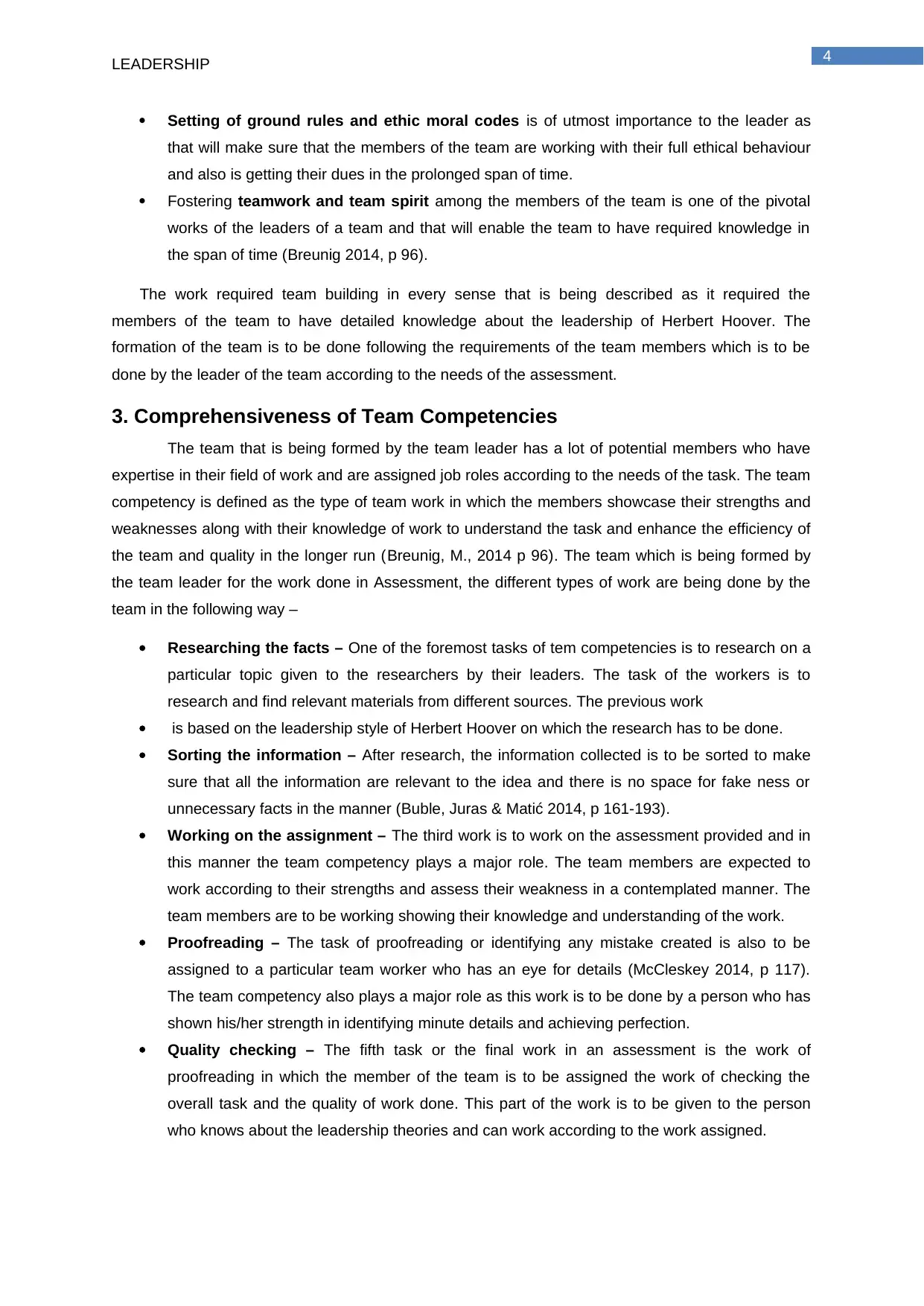
4
LEADERSHIP
Setting of ground rules and ethic moral codes is of utmost importance to the leader as
that will make sure that the members of the team are working with their full ethical behaviour
and also is getting their dues in the prolonged span of time.
Fostering teamwork and team spirit among the members of the team is one of the pivotal
works of the leaders of a team and that will enable the team to have required knowledge in
the span of time (Breunig 2014, p 96).
The work required team building in every sense that is being described as it required the
members of the team to have detailed knowledge about the leadership of Herbert Hoover. The
formation of the team is to be done following the requirements of the team members which is to be
done by the leader of the team according to the needs of the assessment.
3. Comprehensiveness of Team Competencies
The team that is being formed by the team leader has a lot of potential members who have
expertise in their field of work and are assigned job roles according to the needs of the task. The team
competency is defined as the type of team work in which the members showcase their strengths and
weaknesses along with their knowledge of work to understand the task and enhance the efficiency of
the team and quality in the longer run (Breunig, M., 2014 p 96). The team which is being formed by
the team leader for the work done in Assessment, the different types of work are being done by the
team in the following way –
Researching the facts – One of the foremost tasks of tem competencies is to research on a
particular topic given to the researchers by their leaders. The task of the workers is to
research and find relevant materials from different sources. The previous work
is based on the leadership style of Herbert Hoover on which the research has to be done.
Sorting the information – After research, the information collected is to be sorted to make
sure that all the information are relevant to the idea and there is no space for fake ness or
unnecessary facts in the manner (Buble, Juras & Matić 2014, p 161-193).
Working on the assignment – The third work is to work on the assessment provided and in
this manner the team competency plays a major role. The team members are expected to
work according to their strengths and assess their weakness in a contemplated manner. The
team members are to be working showing their knowledge and understanding of the work.
Proofreading – The task of proofreading or identifying any mistake created is also to be
assigned to a particular team worker who has an eye for details (McCleskey 2014, p 117).
The team competency also plays a major role as this work is to be done by a person who has
shown his/her strength in identifying minute details and achieving perfection.
Quality checking – The fifth task or the final work in an assessment is the work of
proofreading in which the member of the team is to be assigned the work of checking the
overall task and the quality of work done. This part of the work is to be given to the person
who knows about the leadership theories and can work according to the work assigned.
LEADERSHIP
Setting of ground rules and ethic moral codes is of utmost importance to the leader as
that will make sure that the members of the team are working with their full ethical behaviour
and also is getting their dues in the prolonged span of time.
Fostering teamwork and team spirit among the members of the team is one of the pivotal
works of the leaders of a team and that will enable the team to have required knowledge in
the span of time (Breunig 2014, p 96).
The work required team building in every sense that is being described as it required the
members of the team to have detailed knowledge about the leadership of Herbert Hoover. The
formation of the team is to be done following the requirements of the team members which is to be
done by the leader of the team according to the needs of the assessment.
3. Comprehensiveness of Team Competencies
The team that is being formed by the team leader has a lot of potential members who have
expertise in their field of work and are assigned job roles according to the needs of the task. The team
competency is defined as the type of team work in which the members showcase their strengths and
weaknesses along with their knowledge of work to understand the task and enhance the efficiency of
the team and quality in the longer run (Breunig, M., 2014 p 96). The team which is being formed by
the team leader for the work done in Assessment, the different types of work are being done by the
team in the following way –
Researching the facts – One of the foremost tasks of tem competencies is to research on a
particular topic given to the researchers by their leaders. The task of the workers is to
research and find relevant materials from different sources. The previous work
is based on the leadership style of Herbert Hoover on which the research has to be done.
Sorting the information – After research, the information collected is to be sorted to make
sure that all the information are relevant to the idea and there is no space for fake ness or
unnecessary facts in the manner (Buble, Juras & Matić 2014, p 161-193).
Working on the assignment – The third work is to work on the assessment provided and in
this manner the team competency plays a major role. The team members are expected to
work according to their strengths and assess their weakness in a contemplated manner. The
team members are to be working showing their knowledge and understanding of the work.
Proofreading – The task of proofreading or identifying any mistake created is also to be
assigned to a particular team worker who has an eye for details (McCleskey 2014, p 117).
The team competency also plays a major role as this work is to be done by a person who has
shown his/her strength in identifying minute details and achieving perfection.
Quality checking – The fifth task or the final work in an assessment is the work of
proofreading in which the member of the team is to be assigned the work of checking the
overall task and the quality of work done. This part of the work is to be given to the person
who knows about the leadership theories and can work according to the work assigned.
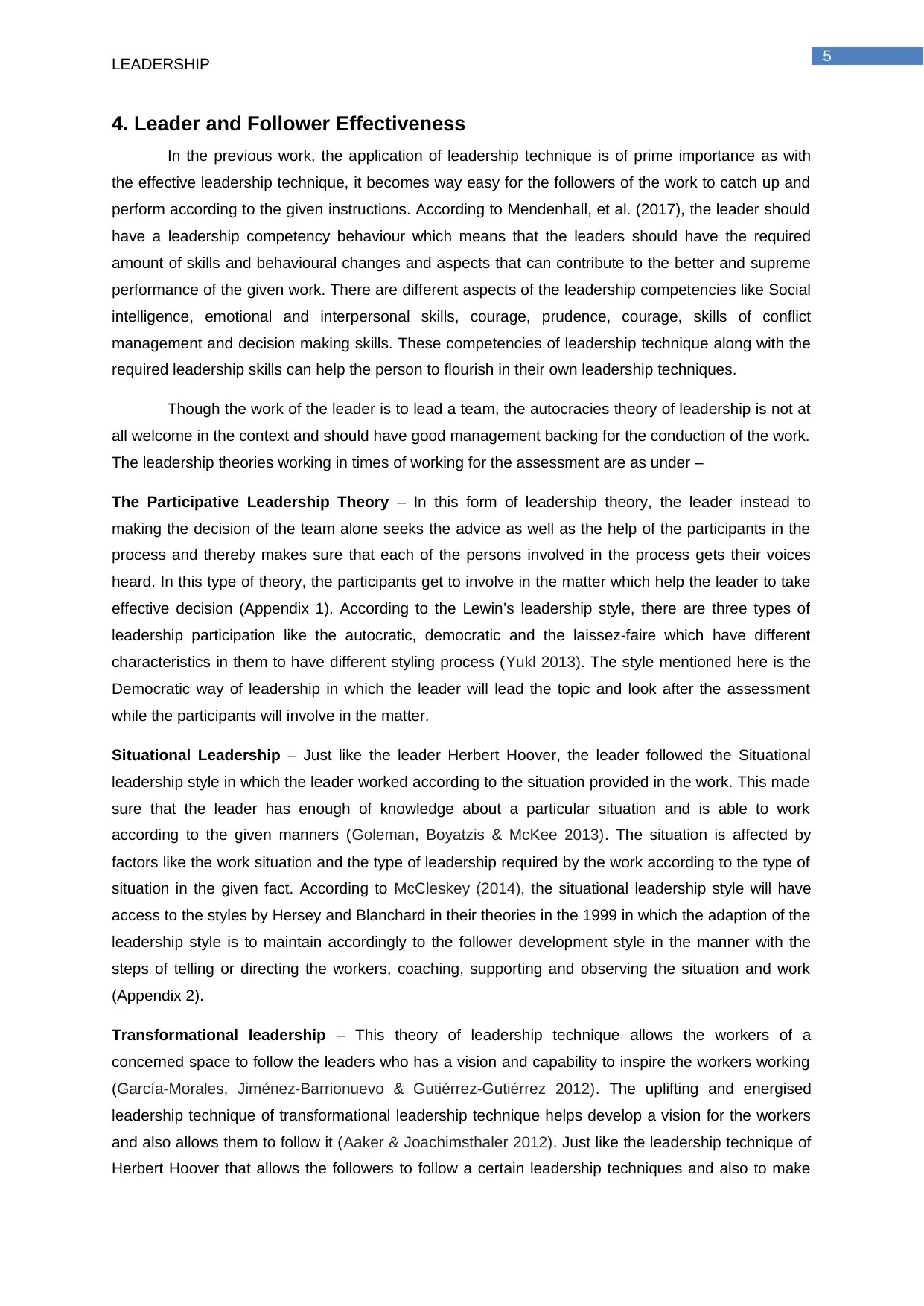
5
LEADERSHIP
4. Leader and Follower Effectiveness
In the previous work, the application of leadership technique is of prime importance as with
the effective leadership technique, it becomes way easy for the followers of the work to catch up and
perform according to the given instructions. According to Mendenhall, et al. (2017), the leader should
have a leadership competency behaviour which means that the leaders should have the required
amount of skills and behavioural changes and aspects that can contribute to the better and supreme
performance of the given work. There are different aspects of the leadership competencies like Social
intelligence, emotional and interpersonal skills, courage, prudence, courage, skills of conflict
management and decision making skills. These competencies of leadership technique along with the
required leadership skills can help the person to flourish in their own leadership techniques.
Though the work of the leader is to lead a team, the autocracies theory of leadership is not at
all welcome in the context and should have good management backing for the conduction of the work.
The leadership theories working in times of working for the assessment are as under –
The Participative Leadership Theory – In this form of leadership theory, the leader instead to
making the decision of the team alone seeks the advice as well as the help of the participants in the
process and thereby makes sure that each of the persons involved in the process gets their voices
heard. In this type of theory, the participants get to involve in the matter which help the leader to take
effective decision (Appendix 1). According to the Lewin’s leadership style, there are three types of
leadership participation like the autocratic, democratic and the laissez-faire which have different
characteristics in them to have different styling process (Yukl 2013). The style mentioned here is the
Democratic way of leadership in which the leader will lead the topic and look after the assessment
while the participants will involve in the matter.
Situational Leadership – Just like the leader Herbert Hoover, the leader followed the Situational
leadership style in which the leader worked according to the situation provided in the work. This made
sure that the leader has enough of knowledge about a particular situation and is able to work
according to the given manners (Goleman, Boyatzis & McKee 2013). The situation is affected by
factors like the work situation and the type of leadership required by the work according to the type of
situation in the given fact. According to McCleskey (2014), the situational leadership style will have
access to the styles by Hersey and Blanchard in their theories in the 1999 in which the adaption of the
leadership style is to maintain accordingly to the follower development style in the manner with the
steps of telling or directing the workers, coaching, supporting and observing the situation and work
(Appendix 2).
Transformational leadership – This theory of leadership technique allows the workers of a
concerned space to follow the leaders who has a vision and capability to inspire the workers working
(García-Morales, Jiménez-Barrionuevo & Gutiérrez-Gutiérrez 2012). The uplifting and energised
leadership technique of transformational leadership technique helps develop a vision for the workers
and also allows them to follow it (Aaker & Joachimsthaler 2012). Just like the leadership technique of
Herbert Hoover that allows the followers to follow a certain leadership techniques and also to make
LEADERSHIP
4. Leader and Follower Effectiveness
In the previous work, the application of leadership technique is of prime importance as with
the effective leadership technique, it becomes way easy for the followers of the work to catch up and
perform according to the given instructions. According to Mendenhall, et al. (2017), the leader should
have a leadership competency behaviour which means that the leaders should have the required
amount of skills and behavioural changes and aspects that can contribute to the better and supreme
performance of the given work. There are different aspects of the leadership competencies like Social
intelligence, emotional and interpersonal skills, courage, prudence, courage, skills of conflict
management and decision making skills. These competencies of leadership technique along with the
required leadership skills can help the person to flourish in their own leadership techniques.
Though the work of the leader is to lead a team, the autocracies theory of leadership is not at
all welcome in the context and should have good management backing for the conduction of the work.
The leadership theories working in times of working for the assessment are as under –
The Participative Leadership Theory – In this form of leadership theory, the leader instead to
making the decision of the team alone seeks the advice as well as the help of the participants in the
process and thereby makes sure that each of the persons involved in the process gets their voices
heard. In this type of theory, the participants get to involve in the matter which help the leader to take
effective decision (Appendix 1). According to the Lewin’s leadership style, there are three types of
leadership participation like the autocratic, democratic and the laissez-faire which have different
characteristics in them to have different styling process (Yukl 2013). The style mentioned here is the
Democratic way of leadership in which the leader will lead the topic and look after the assessment
while the participants will involve in the matter.
Situational Leadership – Just like the leader Herbert Hoover, the leader followed the Situational
leadership style in which the leader worked according to the situation provided in the work. This made
sure that the leader has enough of knowledge about a particular situation and is able to work
according to the given manners (Goleman, Boyatzis & McKee 2013). The situation is affected by
factors like the work situation and the type of leadership required by the work according to the type of
situation in the given fact. According to McCleskey (2014), the situational leadership style will have
access to the styles by Hersey and Blanchard in their theories in the 1999 in which the adaption of the
leadership style is to maintain accordingly to the follower development style in the manner with the
steps of telling or directing the workers, coaching, supporting and observing the situation and work
(Appendix 2).
Transformational leadership – This theory of leadership technique allows the workers of a
concerned space to follow the leaders who has a vision and capability to inspire the workers working
(García-Morales, Jiménez-Barrionuevo & Gutiérrez-Gutiérrez 2012). The uplifting and energised
leadership technique of transformational leadership technique helps develop a vision for the workers
and also allows them to follow it (Aaker & Joachimsthaler 2012). Just like the leadership technique of
Herbert Hoover that allows the followers to follow a certain leadership techniques and also to make
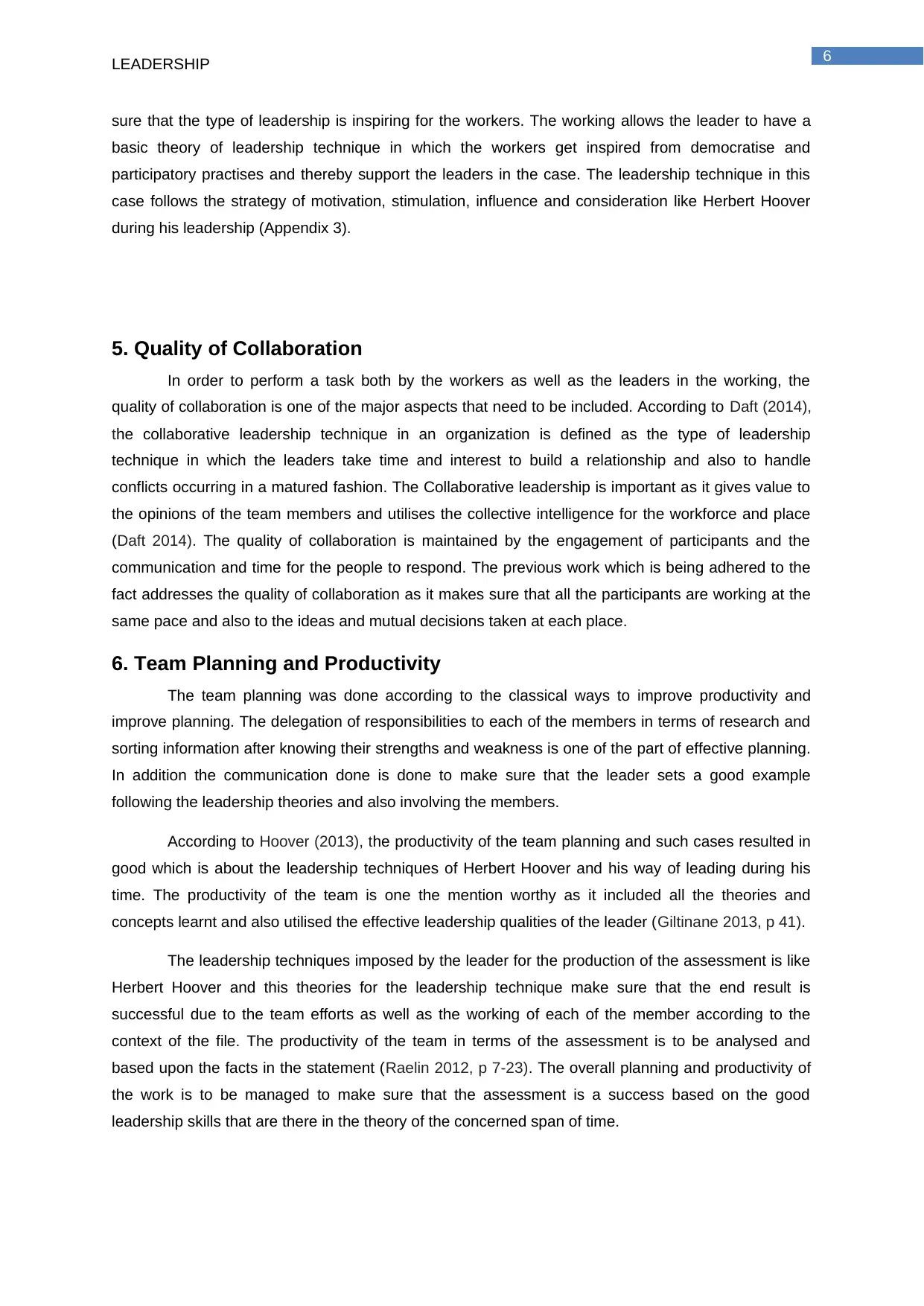
6
LEADERSHIP
sure that the type of leadership is inspiring for the workers. The working allows the leader to have a
basic theory of leadership technique in which the workers get inspired from democratise and
participatory practises and thereby support the leaders in the case. The leadership technique in this
case follows the strategy of motivation, stimulation, influence and consideration like Herbert Hoover
during his leadership (Appendix 3).
5. Quality of Collaboration
In order to perform a task both by the workers as well as the leaders in the working, the
quality of collaboration is one of the major aspects that need to be included. According to Daft (2014),
the collaborative leadership technique in an organization is defined as the type of leadership
technique in which the leaders take time and interest to build a relationship and also to handle
conflicts occurring in a matured fashion. The Collaborative leadership is important as it gives value to
the opinions of the team members and utilises the collective intelligence for the workforce and place
(Daft 2014). The quality of collaboration is maintained by the engagement of participants and the
communication and time for the people to respond. The previous work which is being adhered to the
fact addresses the quality of collaboration as it makes sure that all the participants are working at the
same pace and also to the ideas and mutual decisions taken at each place.
6. Team Planning and Productivity
The team planning was done according to the classical ways to improve productivity and
improve planning. The delegation of responsibilities to each of the members in terms of research and
sorting information after knowing their strengths and weakness is one of the part of effective planning.
In addition the communication done is done to make sure that the leader sets a good example
following the leadership theories and also involving the members.
According to Hoover (2013), the productivity of the team planning and such cases resulted in
good which is about the leadership techniques of Herbert Hoover and his way of leading during his
time. The productivity of the team is one the mention worthy as it included all the theories and
concepts learnt and also utilised the effective leadership qualities of the leader (Giltinane 2013, p 41).
The leadership techniques imposed by the leader for the production of the assessment is like
Herbert Hoover and this theories for the leadership technique make sure that the end result is
successful due to the team efforts as well as the working of each of the member according to the
context of the file. The productivity of the team in terms of the assessment is to be analysed and
based upon the facts in the statement (Raelin 2012, p 7-23). The overall planning and productivity of
the work is to be managed to make sure that the assessment is a success based on the good
leadership skills that are there in the theory of the concerned span of time.
LEADERSHIP
sure that the type of leadership is inspiring for the workers. The working allows the leader to have a
basic theory of leadership technique in which the workers get inspired from democratise and
participatory practises and thereby support the leaders in the case. The leadership technique in this
case follows the strategy of motivation, stimulation, influence and consideration like Herbert Hoover
during his leadership (Appendix 3).
5. Quality of Collaboration
In order to perform a task both by the workers as well as the leaders in the working, the
quality of collaboration is one of the major aspects that need to be included. According to Daft (2014),
the collaborative leadership technique in an organization is defined as the type of leadership
technique in which the leaders take time and interest to build a relationship and also to handle
conflicts occurring in a matured fashion. The Collaborative leadership is important as it gives value to
the opinions of the team members and utilises the collective intelligence for the workforce and place
(Daft 2014). The quality of collaboration is maintained by the engagement of participants and the
communication and time for the people to respond. The previous work which is being adhered to the
fact addresses the quality of collaboration as it makes sure that all the participants are working at the
same pace and also to the ideas and mutual decisions taken at each place.
6. Team Planning and Productivity
The team planning was done according to the classical ways to improve productivity and
improve planning. The delegation of responsibilities to each of the members in terms of research and
sorting information after knowing their strengths and weakness is one of the part of effective planning.
In addition the communication done is done to make sure that the leader sets a good example
following the leadership theories and also involving the members.
According to Hoover (2013), the productivity of the team planning and such cases resulted in
good which is about the leadership techniques of Herbert Hoover and his way of leading during his
time. The productivity of the team is one the mention worthy as it included all the theories and
concepts learnt and also utilised the effective leadership qualities of the leader (Giltinane 2013, p 41).
The leadership techniques imposed by the leader for the production of the assessment is like
Herbert Hoover and this theories for the leadership technique make sure that the end result is
successful due to the team efforts as well as the working of each of the member according to the
context of the file. The productivity of the team in terms of the assessment is to be analysed and
based upon the facts in the statement (Raelin 2012, p 7-23). The overall planning and productivity of
the work is to be managed to make sure that the assessment is a success based on the good
leadership skills that are there in the theory of the concerned span of time.
Paraphrase This Document
Need a fresh take? Get an instant paraphrase of this document with our AI Paraphraser
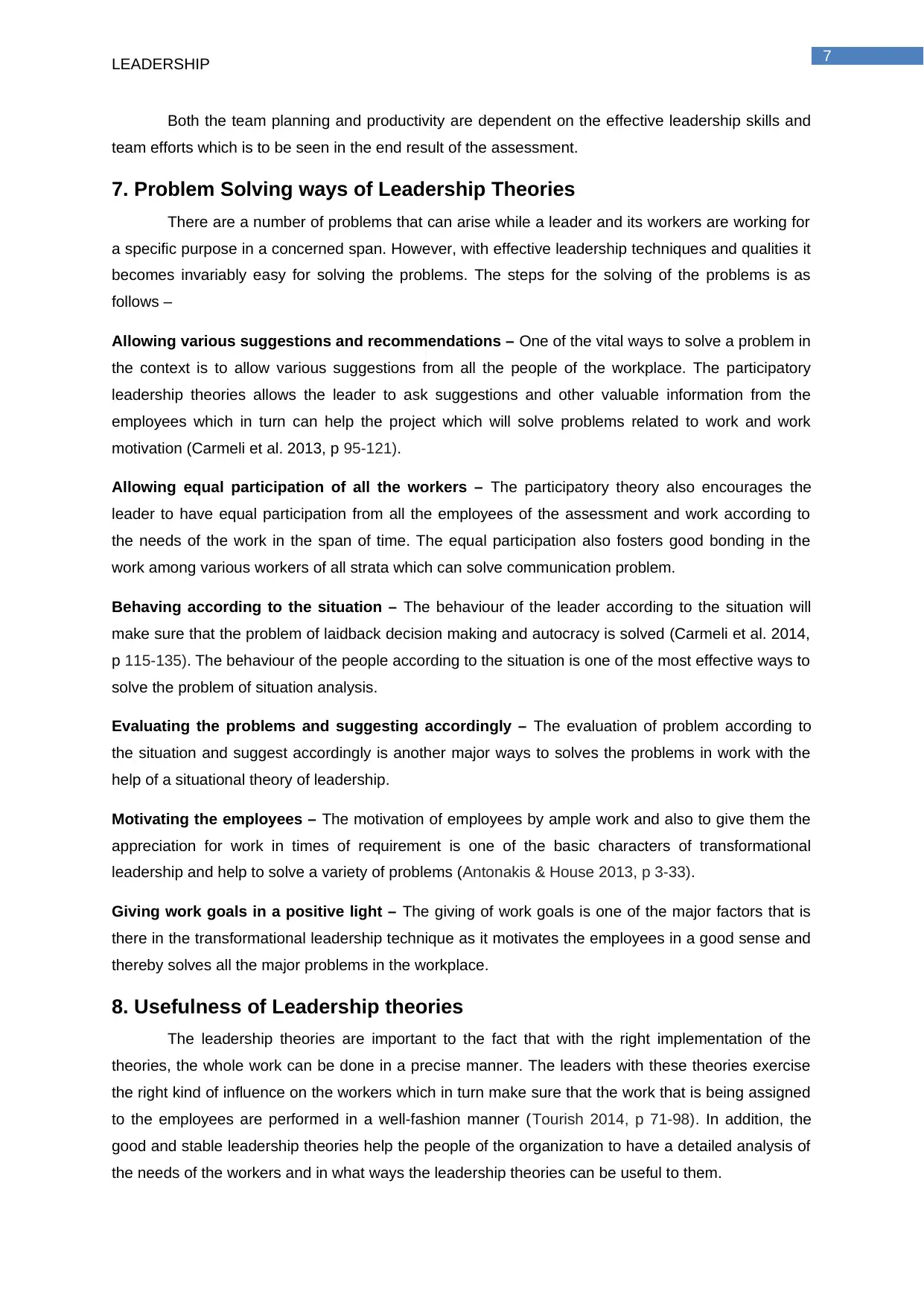
7
LEADERSHIP
Both the team planning and productivity are dependent on the effective leadership skills and
team efforts which is to be seen in the end result of the assessment.
7. Problem Solving ways of Leadership Theories
There are a number of problems that can arise while a leader and its workers are working for
a specific purpose in a concerned span. However, with effective leadership techniques and qualities it
becomes invariably easy for solving the problems. The steps for the solving of the problems is as
follows –
Allowing various suggestions and recommendations – One of the vital ways to solve a problem in
the context is to allow various suggestions from all the people of the workplace. The participatory
leadership theories allows the leader to ask suggestions and other valuable information from the
employees which in turn can help the project which will solve problems related to work and work
motivation (Carmeli et al. 2013, p 95-121).
Allowing equal participation of all the workers – The participatory theory also encourages the
leader to have equal participation from all the employees of the assessment and work according to
the needs of the work in the span of time. The equal participation also fosters good bonding in the
work among various workers of all strata which can solve communication problem.
Behaving according to the situation – The behaviour of the leader according to the situation will
make sure that the problem of laidback decision making and autocracy is solved (Carmeli et al. 2014,
p 115-135). The behaviour of the people according to the situation is one of the most effective ways to
solve the problem of situation analysis.
Evaluating the problems and suggesting accordingly – The evaluation of problem according to
the situation and suggest accordingly is another major ways to solves the problems in work with the
help of a situational theory of leadership.
Motivating the employees – The motivation of employees by ample work and also to give them the
appreciation for work in times of requirement is one of the basic characters of transformational
leadership and help to solve a variety of problems (Antonakis & House 2013, p 3-33).
Giving work goals in a positive light – The giving of work goals is one of the major factors that is
there in the transformational leadership technique as it motivates the employees in a good sense and
thereby solves all the major problems in the workplace.
8. Usefulness of Leadership theories
The leadership theories are important to the fact that with the right implementation of the
theories, the whole work can be done in a precise manner. The leaders with these theories exercise
the right kind of influence on the workers which in turn make sure that the work that is being assigned
to the employees are performed in a well-fashion manner (Tourish 2014, p 71-98). In addition, the
good and stable leadership theories help the people of the organization to have a detailed analysis of
the needs of the workers and in what ways the leadership theories can be useful to them.
LEADERSHIP
Both the team planning and productivity are dependent on the effective leadership skills and
team efforts which is to be seen in the end result of the assessment.
7. Problem Solving ways of Leadership Theories
There are a number of problems that can arise while a leader and its workers are working for
a specific purpose in a concerned span. However, with effective leadership techniques and qualities it
becomes invariably easy for solving the problems. The steps for the solving of the problems is as
follows –
Allowing various suggestions and recommendations – One of the vital ways to solve a problem in
the context is to allow various suggestions from all the people of the workplace. The participatory
leadership theories allows the leader to ask suggestions and other valuable information from the
employees which in turn can help the project which will solve problems related to work and work
motivation (Carmeli et al. 2013, p 95-121).
Allowing equal participation of all the workers – The participatory theory also encourages the
leader to have equal participation from all the employees of the assessment and work according to
the needs of the work in the span of time. The equal participation also fosters good bonding in the
work among various workers of all strata which can solve communication problem.
Behaving according to the situation – The behaviour of the leader according to the situation will
make sure that the problem of laidback decision making and autocracy is solved (Carmeli et al. 2014,
p 115-135). The behaviour of the people according to the situation is one of the most effective ways to
solve the problem of situation analysis.
Evaluating the problems and suggesting accordingly – The evaluation of problem according to
the situation and suggest accordingly is another major ways to solves the problems in work with the
help of a situational theory of leadership.
Motivating the employees – The motivation of employees by ample work and also to give them the
appreciation for work in times of requirement is one of the basic characters of transformational
leadership and help to solve a variety of problems (Antonakis & House 2013, p 3-33).
Giving work goals in a positive light – The giving of work goals is one of the major factors that is
there in the transformational leadership technique as it motivates the employees in a good sense and
thereby solves all the major problems in the workplace.
8. Usefulness of Leadership theories
The leadership theories are important to the fact that with the right implementation of the
theories, the whole work can be done in a precise manner. The leaders with these theories exercise
the right kind of influence on the workers which in turn make sure that the work that is being assigned
to the employees are performed in a well-fashion manner (Tourish 2014, p 71-98). In addition, the
good and stable leadership theories help the people of the organization to have a detailed analysis of
the needs of the workers and in what ways the leadership theories can be useful to them.
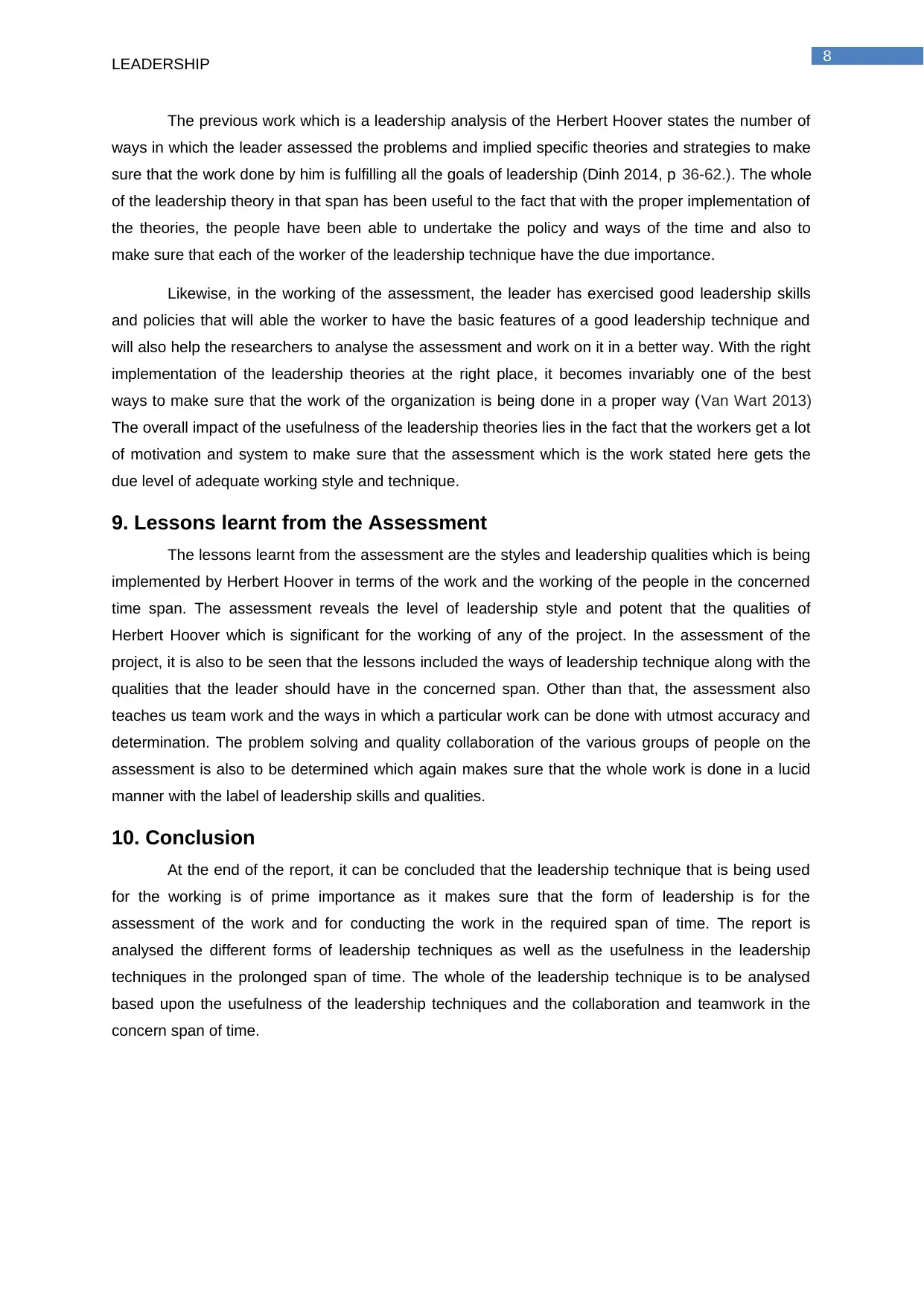
8
LEADERSHIP
The previous work which is a leadership analysis of the Herbert Hoover states the number of
ways in which the leader assessed the problems and implied specific theories and strategies to make
sure that the work done by him is fulfilling all the goals of leadership (Dinh 2014, p 36-62.). The whole
of the leadership theory in that span has been useful to the fact that with the proper implementation of
the theories, the people have been able to undertake the policy and ways of the time and also to
make sure that each of the worker of the leadership technique have the due importance.
Likewise, in the working of the assessment, the leader has exercised good leadership skills
and policies that will able the worker to have the basic features of a good leadership technique and
will also help the researchers to analyse the assessment and work on it in a better way. With the right
implementation of the leadership theories at the right place, it becomes invariably one of the best
ways to make sure that the work of the organization is being done in a proper way (Van Wart 2013)
The overall impact of the usefulness of the leadership theories lies in the fact that the workers get a lot
of motivation and system to make sure that the assessment which is the work stated here gets the
due level of adequate working style and technique.
9. Lessons learnt from the Assessment
The lessons learnt from the assessment are the styles and leadership qualities which is being
implemented by Herbert Hoover in terms of the work and the working of the people in the concerned
time span. The assessment reveals the level of leadership style and potent that the qualities of
Herbert Hoover which is significant for the working of any of the project. In the assessment of the
project, it is also to be seen that the lessons included the ways of leadership technique along with the
qualities that the leader should have in the concerned span. Other than that, the assessment also
teaches us team work and the ways in which a particular work can be done with utmost accuracy and
determination. The problem solving and quality collaboration of the various groups of people on the
assessment is also to be determined which again makes sure that the whole work is done in a lucid
manner with the label of leadership skills and qualities.
10. Conclusion
At the end of the report, it can be concluded that the leadership technique that is being used
for the working is of prime importance as it makes sure that the form of leadership is for the
assessment of the work and for conducting the work in the required span of time. The report is
analysed the different forms of leadership techniques as well as the usefulness in the leadership
techniques in the prolonged span of time. The whole of the leadership technique is to be analysed
based upon the usefulness of the leadership techniques and the collaboration and teamwork in the
concern span of time.
LEADERSHIP
The previous work which is a leadership analysis of the Herbert Hoover states the number of
ways in which the leader assessed the problems and implied specific theories and strategies to make
sure that the work done by him is fulfilling all the goals of leadership (Dinh 2014, p 36-62.). The whole
of the leadership theory in that span has been useful to the fact that with the proper implementation of
the theories, the people have been able to undertake the policy and ways of the time and also to
make sure that each of the worker of the leadership technique have the due importance.
Likewise, in the working of the assessment, the leader has exercised good leadership skills
and policies that will able the worker to have the basic features of a good leadership technique and
will also help the researchers to analyse the assessment and work on it in a better way. With the right
implementation of the leadership theories at the right place, it becomes invariably one of the best
ways to make sure that the work of the organization is being done in a proper way (Van Wart 2013)
The overall impact of the usefulness of the leadership theories lies in the fact that the workers get a lot
of motivation and system to make sure that the assessment which is the work stated here gets the
due level of adequate working style and technique.
9. Lessons learnt from the Assessment
The lessons learnt from the assessment are the styles and leadership qualities which is being
implemented by Herbert Hoover in terms of the work and the working of the people in the concerned
time span. The assessment reveals the level of leadership style and potent that the qualities of
Herbert Hoover which is significant for the working of any of the project. In the assessment of the
project, it is also to be seen that the lessons included the ways of leadership technique along with the
qualities that the leader should have in the concerned span. Other than that, the assessment also
teaches us team work and the ways in which a particular work can be done with utmost accuracy and
determination. The problem solving and quality collaboration of the various groups of people on the
assessment is also to be determined which again makes sure that the whole work is done in a lucid
manner with the label of leadership skills and qualities.
10. Conclusion
At the end of the report, it can be concluded that the leadership technique that is being used
for the working is of prime importance as it makes sure that the form of leadership is for the
assessment of the work and for conducting the work in the required span of time. The report is
analysed the different forms of leadership techniques as well as the usefulness in the leadership
techniques in the prolonged span of time. The whole of the leadership technique is to be analysed
based upon the usefulness of the leadership techniques and the collaboration and teamwork in the
concern span of time.
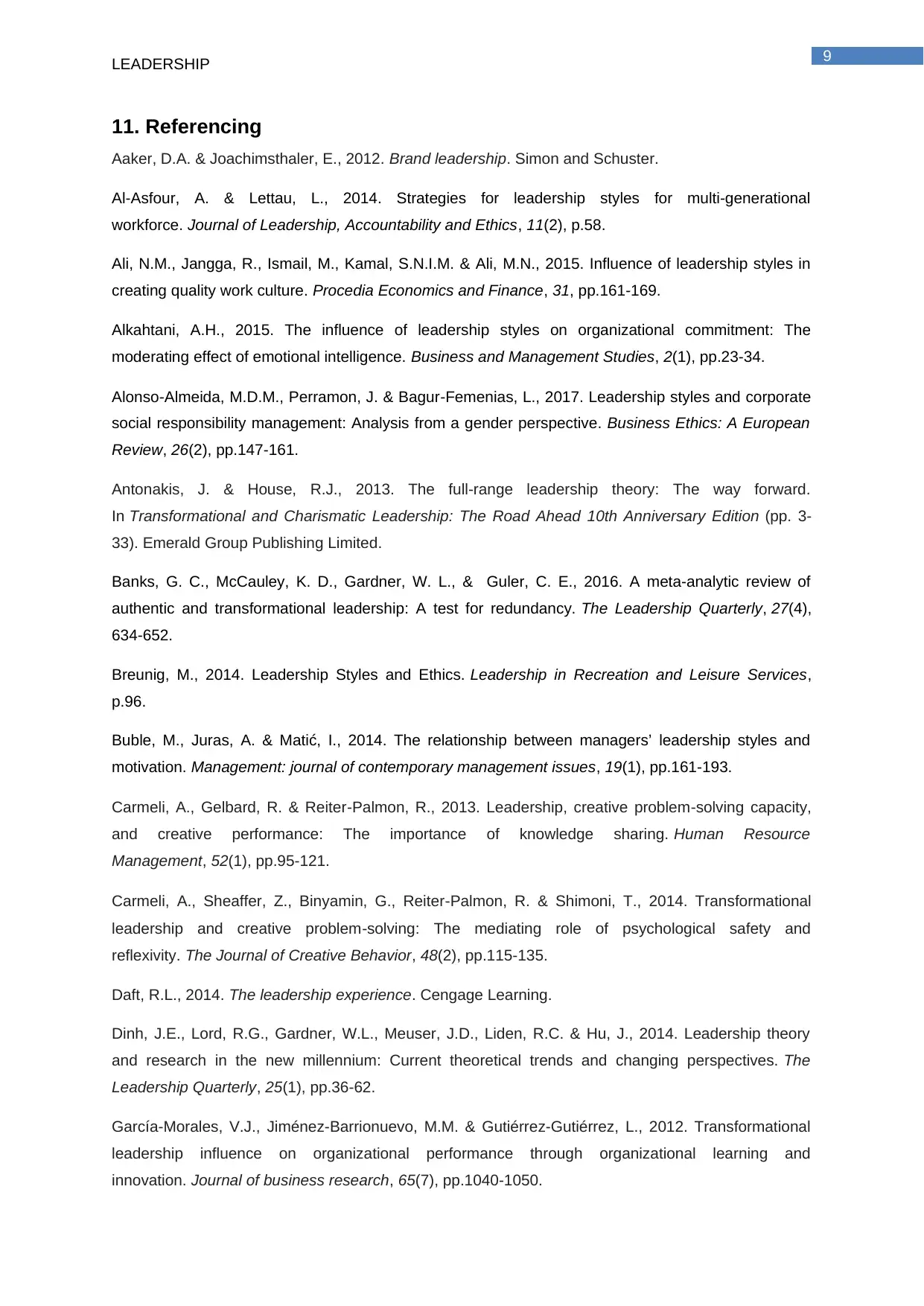
9
LEADERSHIP
11. Referencing
Aaker, D.A. & Joachimsthaler, E., 2012. Brand leadership. Simon and Schuster.
Al-Asfour, A. & Lettau, L., 2014. Strategies for leadership styles for multi-generational
workforce. Journal of Leadership, Accountability and Ethics, 11(2), p.58.
Ali, N.M., Jangga, R., Ismail, M., Kamal, S.N.I.M. & Ali, M.N., 2015. Influence of leadership styles in
creating quality work culture. Procedia Economics and Finance, 31, pp.161-169.
Alkahtani, A.H., 2015. The influence of leadership styles on organizational commitment: The
moderating effect of emotional intelligence. Business and Management Studies, 2(1), pp.23-34.
Alonso‐Almeida, M.D.M., Perramon, J. & Bagur‐Femenias, L., 2017. Leadership styles and corporate
social responsibility management: Analysis from a gender perspective. Business Ethics: A European
Review, 26(2), pp.147-161.
Antonakis, J. & House, R.J., 2013. The full-range leadership theory: The way forward.
In Transformational and Charismatic Leadership: The Road Ahead 10th Anniversary Edition (pp. 3-
33). Emerald Group Publishing Limited.
Banks, G. C., McCauley, K. D., Gardner, W. L., & Guler, C. E., 2016. A meta-analytic review of
authentic and transformational leadership: A test for redundancy. The Leadership Quarterly, 27(4),
634-652.
Breunig, M., 2014. Leadership Styles and Ethics. Leadership in Recreation and Leisure Services,
p.96.
Buble, M., Juras, A. & Matić, I., 2014. The relationship between managers’ leadership styles and
motivation. Management: journal of contemporary management issues, 19(1), pp.161-193.
Carmeli, A., Gelbard, R. & Reiter‐Palmon, R., 2013. Leadership, creative problem‐solving capacity,
and creative performance: The importance of knowledge sharing. Human Resource
Management, 52(1), pp.95-121.
Carmeli, A., Sheaffer, Z., Binyamin, G., Reiter‐Palmon, R. & Shimoni, T., 2014. Transformational
leadership and creative problem‐solving: The mediating role of psychological safety and
reflexivity. The Journal of Creative Behavior, 48(2), pp.115-135.
Daft, R.L., 2014. The leadership experience. Cengage Learning.
Dinh, J.E., Lord, R.G., Gardner, W.L., Meuser, J.D., Liden, R.C. & Hu, J., 2014. Leadership theory
and research in the new millennium: Current theoretical trends and changing perspectives. The
Leadership Quarterly, 25(1), pp.36-62.
García-Morales, V.J., Jiménez-Barrionuevo, M.M. & Gutiérrez-Gutiérrez, L., 2012. Transformational
leadership influence on organizational performance through organizational learning and
innovation. Journal of business research, 65(7), pp.1040-1050.
LEADERSHIP
11. Referencing
Aaker, D.A. & Joachimsthaler, E., 2012. Brand leadership. Simon and Schuster.
Al-Asfour, A. & Lettau, L., 2014. Strategies for leadership styles for multi-generational
workforce. Journal of Leadership, Accountability and Ethics, 11(2), p.58.
Ali, N.M., Jangga, R., Ismail, M., Kamal, S.N.I.M. & Ali, M.N., 2015. Influence of leadership styles in
creating quality work culture. Procedia Economics and Finance, 31, pp.161-169.
Alkahtani, A.H., 2015. The influence of leadership styles on organizational commitment: The
moderating effect of emotional intelligence. Business and Management Studies, 2(1), pp.23-34.
Alonso‐Almeida, M.D.M., Perramon, J. & Bagur‐Femenias, L., 2017. Leadership styles and corporate
social responsibility management: Analysis from a gender perspective. Business Ethics: A European
Review, 26(2), pp.147-161.
Antonakis, J. & House, R.J., 2013. The full-range leadership theory: The way forward.
In Transformational and Charismatic Leadership: The Road Ahead 10th Anniversary Edition (pp. 3-
33). Emerald Group Publishing Limited.
Banks, G. C., McCauley, K. D., Gardner, W. L., & Guler, C. E., 2016. A meta-analytic review of
authentic and transformational leadership: A test for redundancy. The Leadership Quarterly, 27(4),
634-652.
Breunig, M., 2014. Leadership Styles and Ethics. Leadership in Recreation and Leisure Services,
p.96.
Buble, M., Juras, A. & Matić, I., 2014. The relationship between managers’ leadership styles and
motivation. Management: journal of contemporary management issues, 19(1), pp.161-193.
Carmeli, A., Gelbard, R. & Reiter‐Palmon, R., 2013. Leadership, creative problem‐solving capacity,
and creative performance: The importance of knowledge sharing. Human Resource
Management, 52(1), pp.95-121.
Carmeli, A., Sheaffer, Z., Binyamin, G., Reiter‐Palmon, R. & Shimoni, T., 2014. Transformational
leadership and creative problem‐solving: The mediating role of psychological safety and
reflexivity. The Journal of Creative Behavior, 48(2), pp.115-135.
Daft, R.L., 2014. The leadership experience. Cengage Learning.
Dinh, J.E., Lord, R.G., Gardner, W.L., Meuser, J.D., Liden, R.C. & Hu, J., 2014. Leadership theory
and research in the new millennium: Current theoretical trends and changing perspectives. The
Leadership Quarterly, 25(1), pp.36-62.
García-Morales, V.J., Jiménez-Barrionuevo, M.M. & Gutiérrez-Gutiérrez, L., 2012. Transformational
leadership influence on organizational performance through organizational learning and
innovation. Journal of business research, 65(7), pp.1040-1050.
Secure Best Marks with AI Grader
Need help grading? Try our AI Grader for instant feedback on your assignments.
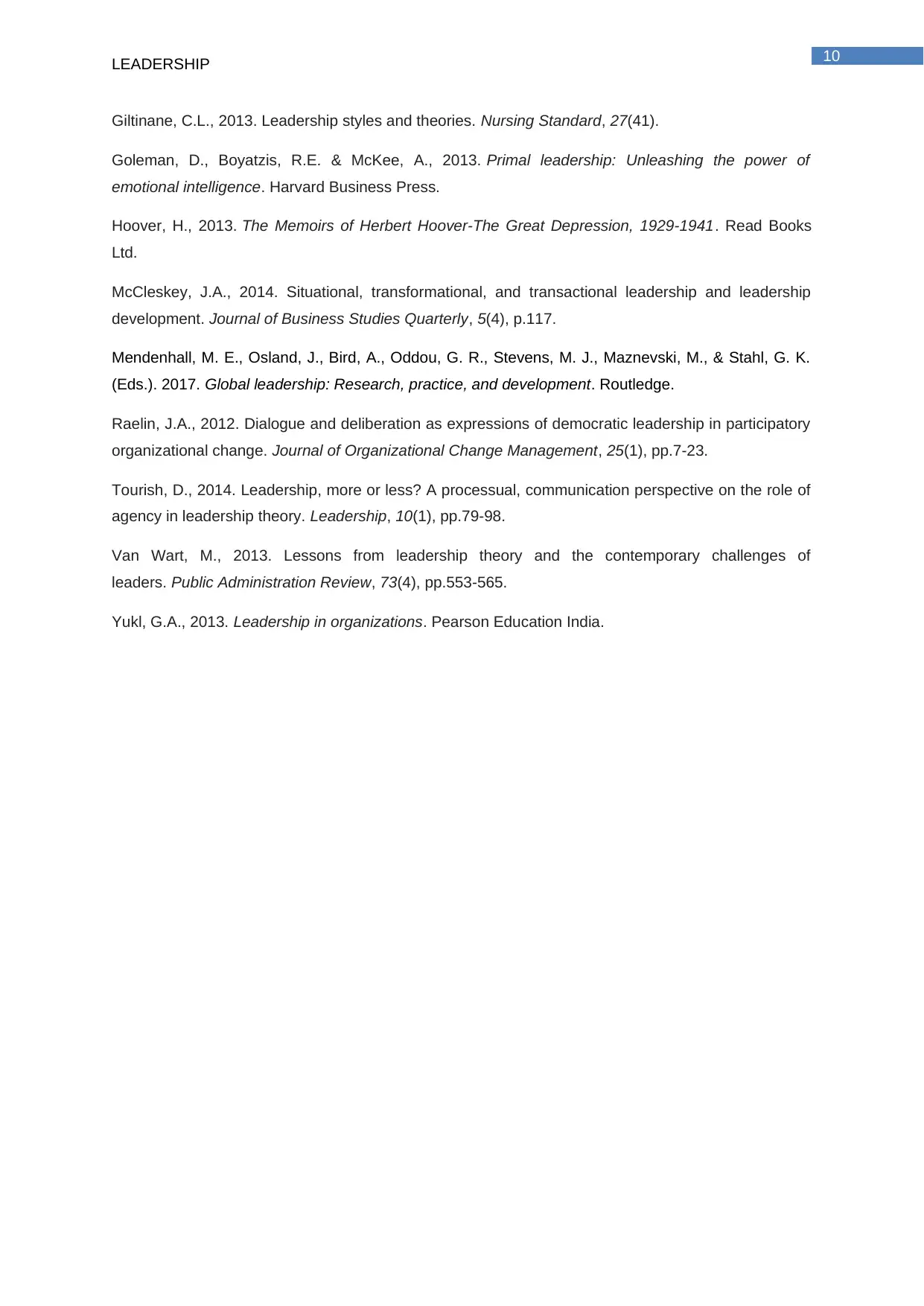
10
LEADERSHIP
Giltinane, C.L., 2013. Leadership styles and theories. Nursing Standard, 27(41).
Goleman, D., Boyatzis, R.E. & McKee, A., 2013. Primal leadership: Unleashing the power of
emotional intelligence. Harvard Business Press.
Hoover, H., 2013. The Memoirs of Herbert Hoover-The Great Depression, 1929-1941. Read Books
Ltd.
McCleskey, J.A., 2014. Situational, transformational, and transactional leadership and leadership
development. Journal of Business Studies Quarterly, 5(4), p.117.
Mendenhall, M. E., Osland, J., Bird, A., Oddou, G. R., Stevens, M. J., Maznevski, M., & Stahl, G. K.
(Eds.). 2017. Global leadership: Research, practice, and development. Routledge.
Raelin, J.A., 2012. Dialogue and deliberation as expressions of democratic leadership in participatory
organizational change. Journal of Organizational Change Management, 25(1), pp.7-23.
Tourish, D., 2014. Leadership, more or less? A processual, communication perspective on the role of
agency in leadership theory. Leadership, 10(1), pp.79-98.
Van Wart, M., 2013. Lessons from leadership theory and the contemporary challenges of
leaders. Public Administration Review, 73(4), pp.553-565.
Yukl, G.A., 2013. Leadership in organizations. Pearson Education India.
LEADERSHIP
Giltinane, C.L., 2013. Leadership styles and theories. Nursing Standard, 27(41).
Goleman, D., Boyatzis, R.E. & McKee, A., 2013. Primal leadership: Unleashing the power of
emotional intelligence. Harvard Business Press.
Hoover, H., 2013. The Memoirs of Herbert Hoover-The Great Depression, 1929-1941. Read Books
Ltd.
McCleskey, J.A., 2014. Situational, transformational, and transactional leadership and leadership
development. Journal of Business Studies Quarterly, 5(4), p.117.
Mendenhall, M. E., Osland, J., Bird, A., Oddou, G. R., Stevens, M. J., Maznevski, M., & Stahl, G. K.
(Eds.). 2017. Global leadership: Research, practice, and development. Routledge.
Raelin, J.A., 2012. Dialogue and deliberation as expressions of democratic leadership in participatory
organizational change. Journal of Organizational Change Management, 25(1), pp.7-23.
Tourish, D., 2014. Leadership, more or less? A processual, communication perspective on the role of
agency in leadership theory. Leadership, 10(1), pp.79-98.
Van Wart, M., 2013. Lessons from leadership theory and the contemporary challenges of
leaders. Public Administration Review, 73(4), pp.553-565.
Yukl, G.A., 2013. Leadership in organizations. Pearson Education India.
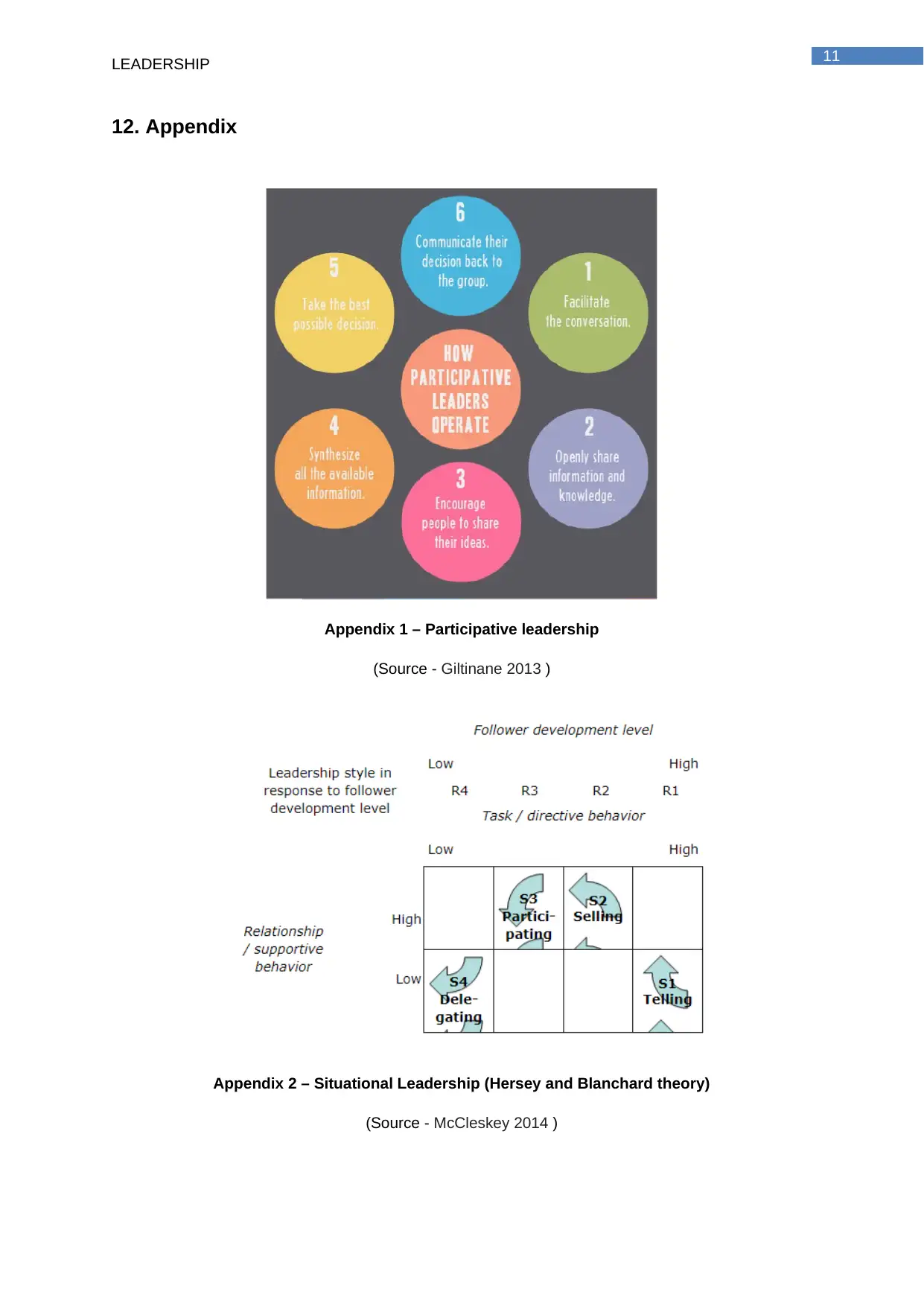
11
LEADERSHIP
12. Appendix
Appendix 1 – Participative leadership
(Source - Giltinane 2013 )
Appendix 2 – Situational Leadership (Hersey and Blanchard theory)
(Source - McCleskey 2014 )
LEADERSHIP
12. Appendix
Appendix 1 – Participative leadership
(Source - Giltinane 2013 )
Appendix 2 – Situational Leadership (Hersey and Blanchard theory)
(Source - McCleskey 2014 )
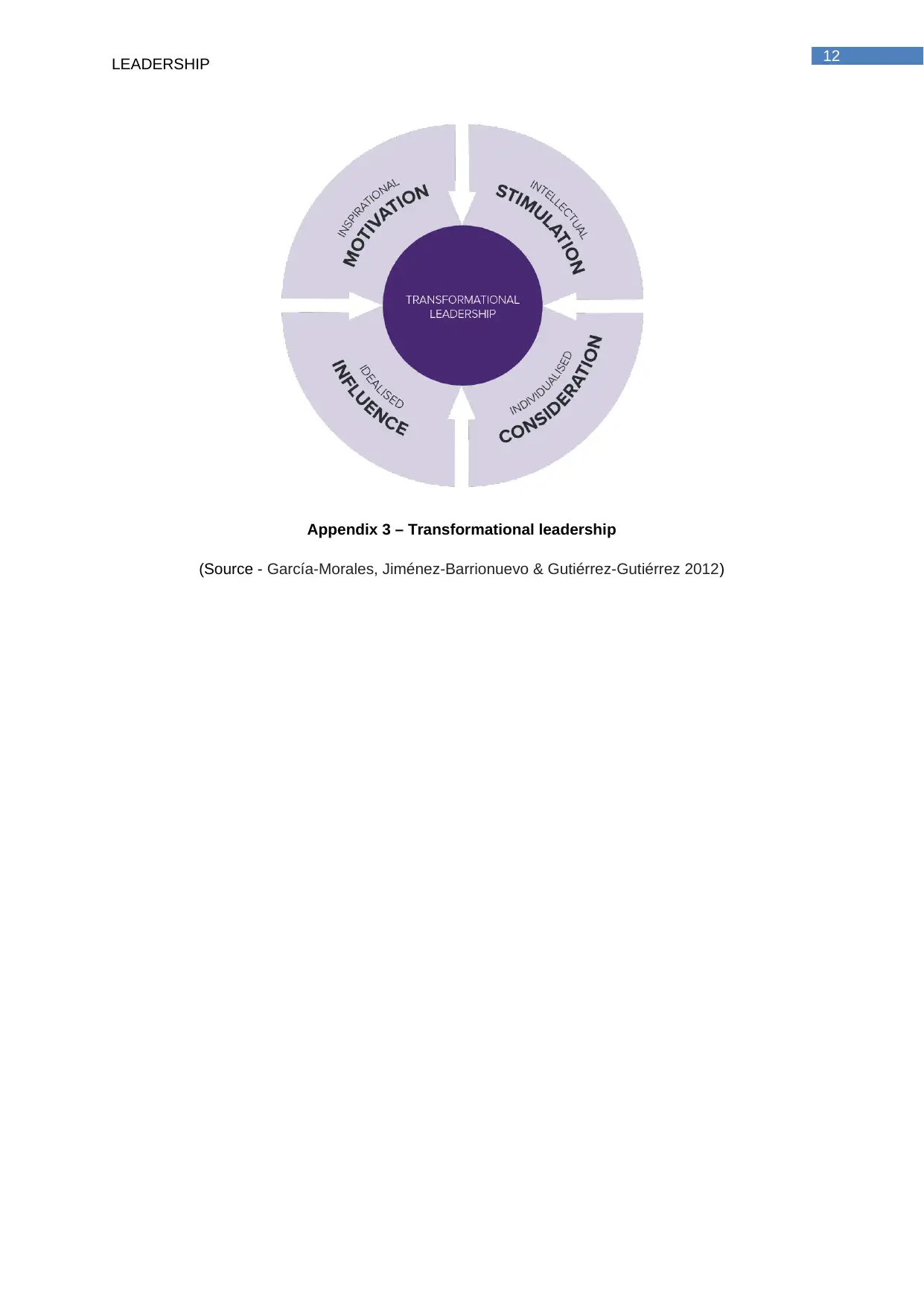
12
LEADERSHIP
Appendix 3 – Transformational leadership
(Source - García-Morales, Jiménez-Barrionuevo & Gutiérrez-Gutiérrez 2012)
LEADERSHIP
Appendix 3 – Transformational leadership
(Source - García-Morales, Jiménez-Barrionuevo & Gutiérrez-Gutiérrez 2012)
1 out of 13
Related Documents
Your All-in-One AI-Powered Toolkit for Academic Success.
+13062052269
info@desklib.com
Available 24*7 on WhatsApp / Email
![[object Object]](/_next/static/media/star-bottom.7253800d.svg)
Unlock your academic potential
© 2024 | Zucol Services PVT LTD | All rights reserved.




